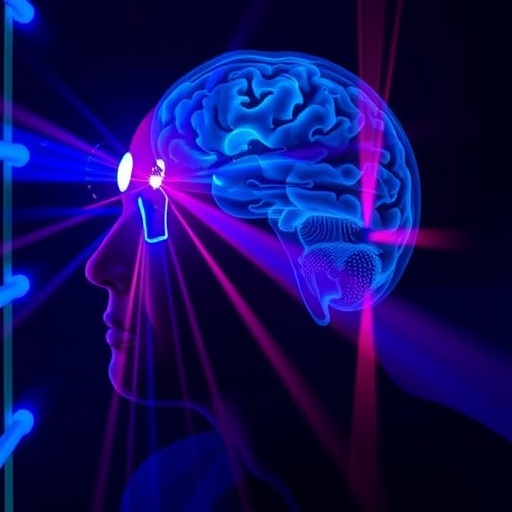In the realm of medical innovation, a new beacon of hope has emerged for those suffering from the debilitating condition of episodic migraine. Recent research centers on the efficacy of auricular neuromodulation, accomplished through low-level laser therapy (LLLT), as compared to traditional placebo therapies. The controlled, randomized study protocol spearheaded by researchers Sagui, Kereun, and Guillemet is poised to make significant strides in how we understand and treat migraines, which affect millions globally.
Migraine is one of the most common neurological conditions, characterized by recurrent headaches that can severely impair daily functioning. Its episodic nature, alongside pulsating pain, often accompanied by nausea and hypersensitivity to light and sound, showcases the dire need for effective prophylactic treatments. Current therapies often revolve around pharmacological solutions, but they frequently fall short due to side effects or intolerability. Thus, the exploration into alternative therapeutic modalities like LLLT provides a refreshing perspective in the ongoing battle against migraine.
Auricular neuromodulation, a technique that targets specific points on the ear, operates on the principle that the ear serves as a microcosm of the body, where stimulation can produce systemic effects. By using low-level laser therapy, it aims to activate these points non-invasively, thus potentially recalibrating the neurovascular pathways involved in migraine attacks. This concept is grounded in both traditional acupuncture principles as well as modern neurophysiology, where the interaction of light with biological tissues can induce profound physiological responses.
The study protocol outlined by these researchers is groundbreaking not just in its focus on LLLT, but also in its structured approach to rigorously determine its effectiveness when compared to placebo treatments. The randomized controlled trial design is regarded as the gold standard in clinical research, ensuring that the outcomes—from headache frequency to intensity—are measured with high fidelity. Such diligence is intended to yield robust conclusions that can either establish a new standard of care or reaffirm existing methodologies in migraine management.
Preliminary findings from similar studies have indicated that LLLT may enhance pain thresholds and decrease nociceptive responses, suggesting a dual mechanism of action where both pain relief and prevention could occur simultaneously. This begs the question: can LLLT become a cornerstone of migraine prophylaxis? If successful, it could open doors not just for efficacy against migraines but also establish a framework for treating other chronic pain conditions.
In practical terms, the protocol will involve a diverse participant cohort, selected to provide insights across a spectrum of migraine presentations. Participants will be randomized into groups receiving either active low-level laser treatment or a placebo, designed to mimic the experience without any therapeutic effects. This careful design seeks to mitigate bias and ensure that any differences observed are indeed attributable to the treatment itself, representing the utmost diligence in clinical investigation.
Another vital component of this research is the consideration of patient-reported outcomes. Understanding a patient’s subjective experience is crucial, as their reports of pain relief or adverse effects will significantly contribute to the interpretation of the quantitative data. Surveys and questionnaires will measure not only the frequency and severity of migraine attacks but also the overall quality of life, an often-overlooked aspect in clinical trials. Thus, the study will strive to present a holistic view of treatment effectiveness.
Moreover, the implications of successful findings extend beyond mere numbers. If low-level laser therapy proves effective, healthcare providers may consider integrating this approach into routine practice, thereby reducing reliance on pharmaceuticals. This pivot has the potential to lower side effects and improve patients’ overall experiences in managing their migraines.
Furthermore, the research aligns with broader trends emphasizing non-pharmacological pain management strategies. As the medical community grapples with the growing concerns around opioid dependency and adverse drug reactions, innovative modalities like LLLT represent a vital shift towards safer treatment paradigms. Should this study validate the benefits of LLLT, it could inspire further investigations into its applicability across various types of pain syndromes.
Ultimately, clinical trials of this nature not only enhance our understanding of migraine management but also exemplify the collaborative spirit ingrained within scientific research. The contributions from multidisciplinary teams, harnessing insights from neurobiology, pain psychology, and clinical practices, culminate in comprehensive protocols that can shape future therapeutic frameworks.
For patients and advocates alike, the gravity of this research cannot be overstated. The hope for a treatment that not only alleviates acute episodes but actively reduces the frequency of onset could significantly change lives. Those afflicted with episodic migraines can only anticipate the outcomes of this trial, as researchers diligently work towards unveiling what could be a transformative approach to pain management.
In conclusion, the randomized controlled study protocol examining auricular neuromodulation through low-level laser therapy holds promise not just for individuals suffering from migraines, but for the larger medical community aiming to pioneer safer and more effective treatment strategies. As this research progresses, the anticipation builds: could this be the answer that millions have been waiting for in their fight against migraine?
Subject of Research: Auricular neuromodulation by low-level laser therapy for the prophylactic treatment of episodic migraine
Article Title: Auricular neuromodulation by low level laser therapy versus placebo laser therapy in prophylactic treatment of episodic migraine: a randomized controlled study protocol
Article References:
Sagui, E., Kereun, E., Guillemet, G. et al. Auricular neuromodulation by low level laser therapy versus placebo laser therapy in prophylactic treatment of episodic migraine: a randomized controlled study protocol.
BMC Complement Med Ther 25, 371 (2025). https://doi.org/10.1186/s12906-025-05068-6
Image Credits: AI Generated
DOI: 10.1186/s12906-025-05068-6
Keywords: Auricular neuromodulation, low-level laser therapy, episodic migraine, randomized controlled trial, non-pharmacological treatment.
Tags: alternative therapies for migraine reliefauricular neuromodulation techniqueschronic headache management solutionsefficacy of laser therapy in neurologyfuture of migraine treatment optionslaser therapy for migraine preventionlow-level laser therapy researchmigraine prophylaxis innovationsneurovascular pathway recalibrationnon-invasive migraine treatmentsplacebo-controlled migraine studiesside effects of traditional migraine medications





